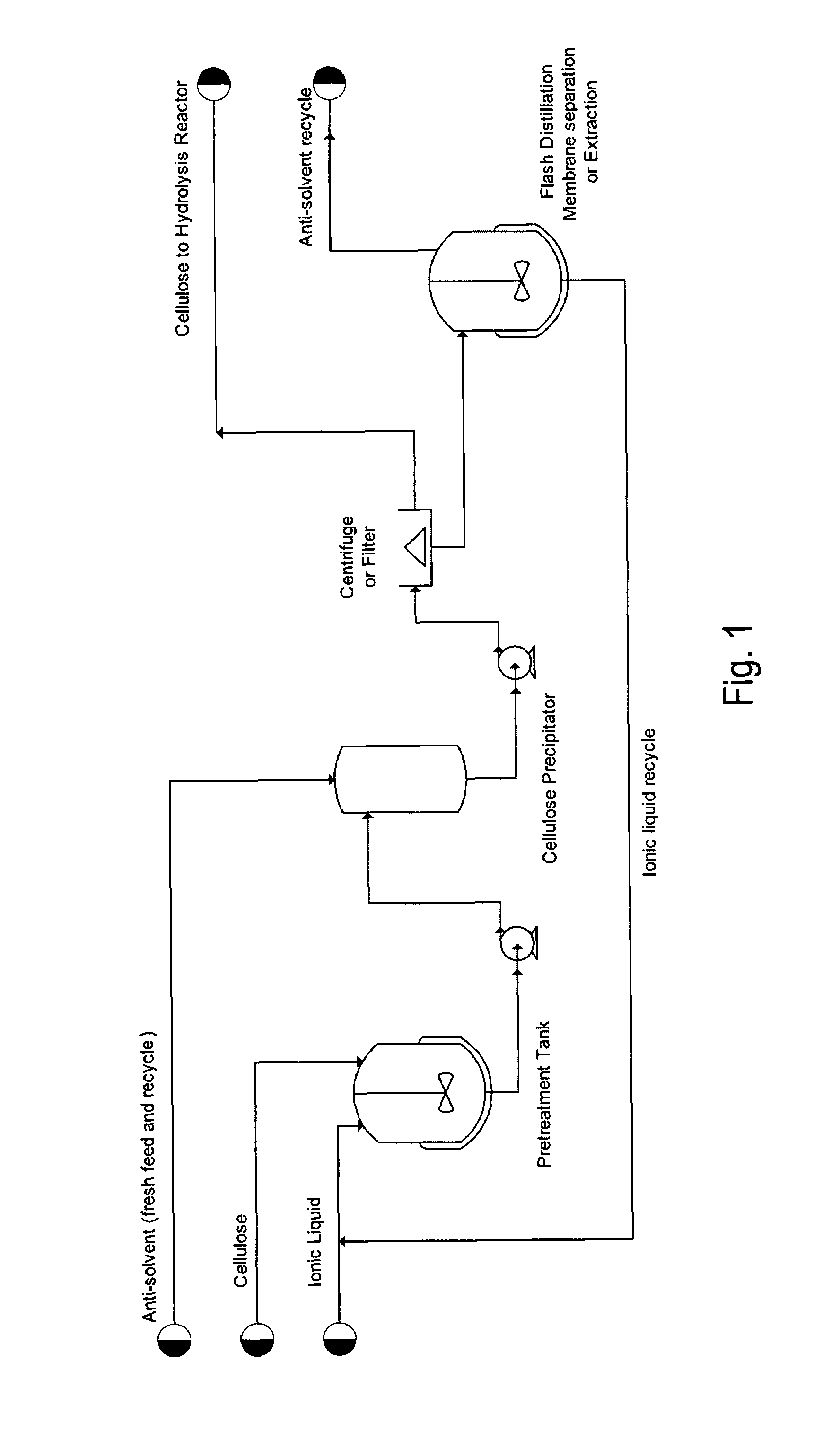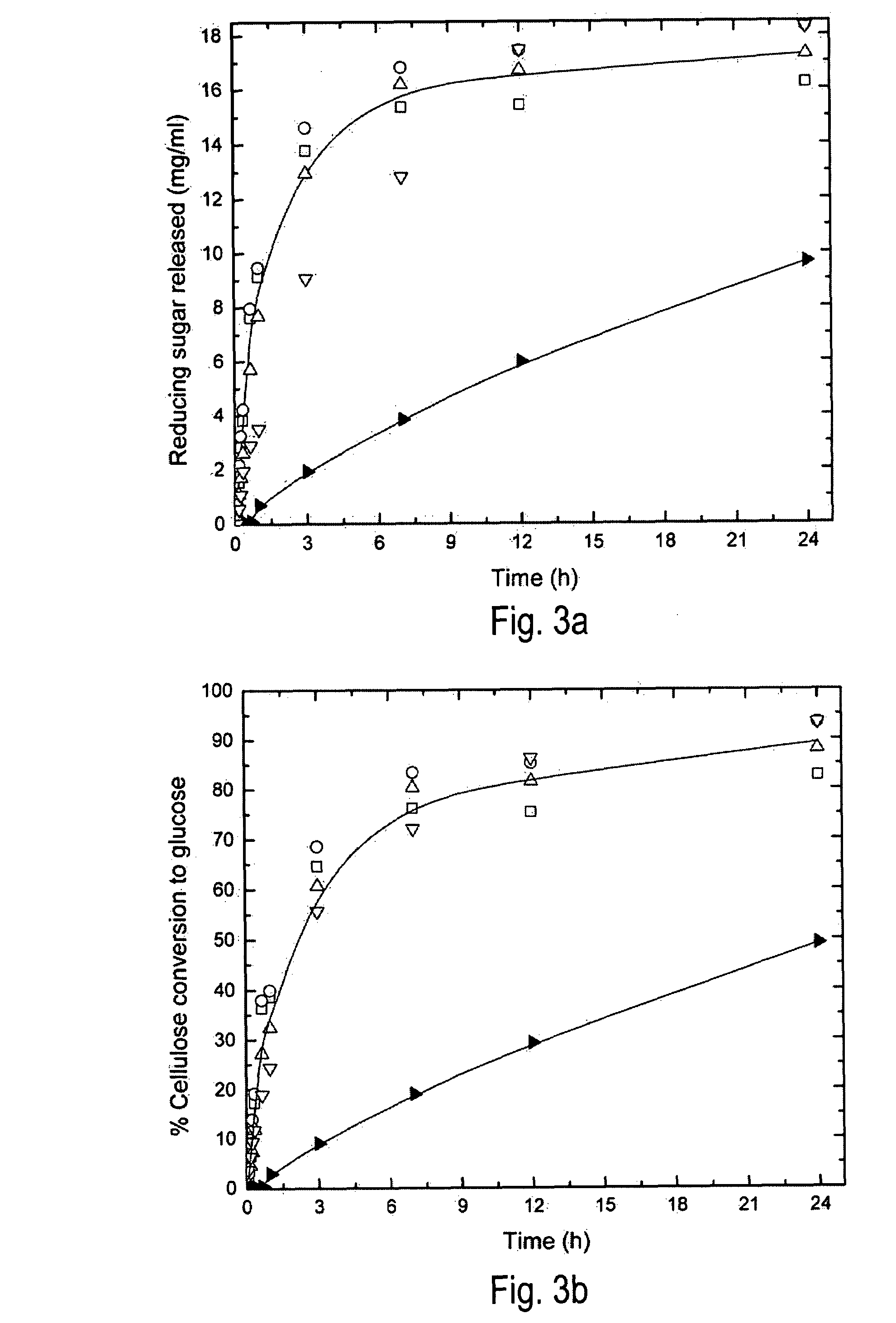Saccharifying cellulose
a technology of cellulose and cellulose, which is applied in the field of saccharification of cellulose, can solve the problems of slow reaction rate of cellulose hydrolysis in aqueous media, and achieve the effects of increasing the surface area accessible, slow reaction rate and hydrolysis of cellulos
- Summary
- Abstract
- Description
- Claims
- Application Information
AI Technical Summary
Benefits of technology
Problems solved by technology
Method used
Image
Examples
example 1
Structure of Regenerated Cellulose (RC)
[0016]X-ray powder diffraction (XRD) data were obtained for IL-treated cellulose to assess crystallinity of recovered samples. Cellulose was fully dissolved in BMIMCI before precipitation with addition of anti-solvent for experiments outlined in this example. Anti-solvent selection, incubation time and temperature were varied.
[0017]Micro-crystalline cellulose, Avicel PH-101 (FMC Corp., Philadelphia, Pa.) was obtained from Sigma Aldrich, St. Louis, Mo. A 5% (w / w) cellulose solution was prepared by combining 50 mg of cellulose with 950 mg of 1-n-butyl-3-methylimidazolium chloride BMIMCI in a 5 ml autoclave vial. The vial and the contents were heated in a block heater to 130° C. and incubated for 10 minutes. The samples were gently stirred by placing the block heater on an orbital shaker.
[0018]Water, methanol and ethanol were used as anti-solvents for precipitating cellulose from BMIMCI. About 2 ml of anti-solvent was added to the cellulose / BMIMCI...
example 2
Initial Hydrolysis Rates of Regenerated Cellulose by Cellulase
[0020]For hydrolysis experiments, Avicel was regenerated by dissolution in BMIMCI followed by precipitation with water, methanol, or ethanol. Alternative anti-solvents methanol and ethanol were examined because BMIMCI is more easily recovered, following cellulose regeneration, from volatile organic solvents than water through a simple distillation step. Batch enzymatic hydrolysis of regenerated and untreated cellulose was carried out at 50° C. in a reciprocating shaker bath. Total batch volume was approximately 3 ml with a cellulase enzyme concentration of 60 FPU / g glucan, and substrate concentration of about 17 mg / ml. Solutions were buffered with 0.05M sodium citrate, pH 4.8. The enzyme reaction was monitored by withdrawing samples from the supernatant periodically and measuring release of soluble reducing sugars by the DNS assay (Miller G L. (1959) Anal. Chem. 31(3):426-428). Untreated and regenerated cellulose were hyd...
example 3
Initial Hydrolysis Rates of Regenerated Cellulose by Cellulases in the Presence of Additional β-glucosidase
[0023]In this example the effect of augmenting cellulase (Celluclast 1.5L, a Trichoderma reesei cellulase) with additional β-glucosidase (Novozyme 188, a cellobiase) on the rates of hydrolysis of untreated and regenerated cellulose was investigated. The enzymes were obtained from Novozyme Corp., Bagsvaerd, Denmark. Cellulase activity was determined by the standard filter paper assay and expressed as filter paper units (FPU) per gram of glucan (Gosh, T. K., (1987), Pure Appl. Chem., 59, 257-268). Cellobiase activity was determined by a cellobiose hydrolysis assay (Gosh, T. K., (1987), Pure Appl. Chem., 59, 257-268) and expressed as cellobiose units (CBU) per gram of glucan.
[0024]A batch volume of 3 ml with a cellulose concentration of 16.7 mg / ml was used with both untreated cellulose and regenerated-cellulose (recovered from 5% (w / w) cellulose-BMIMCI mixture using de-ionized wat...
PUM
| Property | Measurement | Unit |
|---|---|---|
| temperature | aaaaa | aaaaa |
| temperatures | aaaaa | aaaaa |
| temperature | aaaaa | aaaaa |
Abstract
Description
Claims
Application Information
 Login to View More
Login to View More - R&D
- Intellectual Property
- Life Sciences
- Materials
- Tech Scout
- Unparalleled Data Quality
- Higher Quality Content
- 60% Fewer Hallucinations
Browse by: Latest US Patents, China's latest patents, Technical Efficacy Thesaurus, Application Domain, Technology Topic, Popular Technical Reports.
© 2025 PatSnap. All rights reserved.Legal|Privacy policy|Modern Slavery Act Transparency Statement|Sitemap|About US| Contact US: help@patsnap.com



